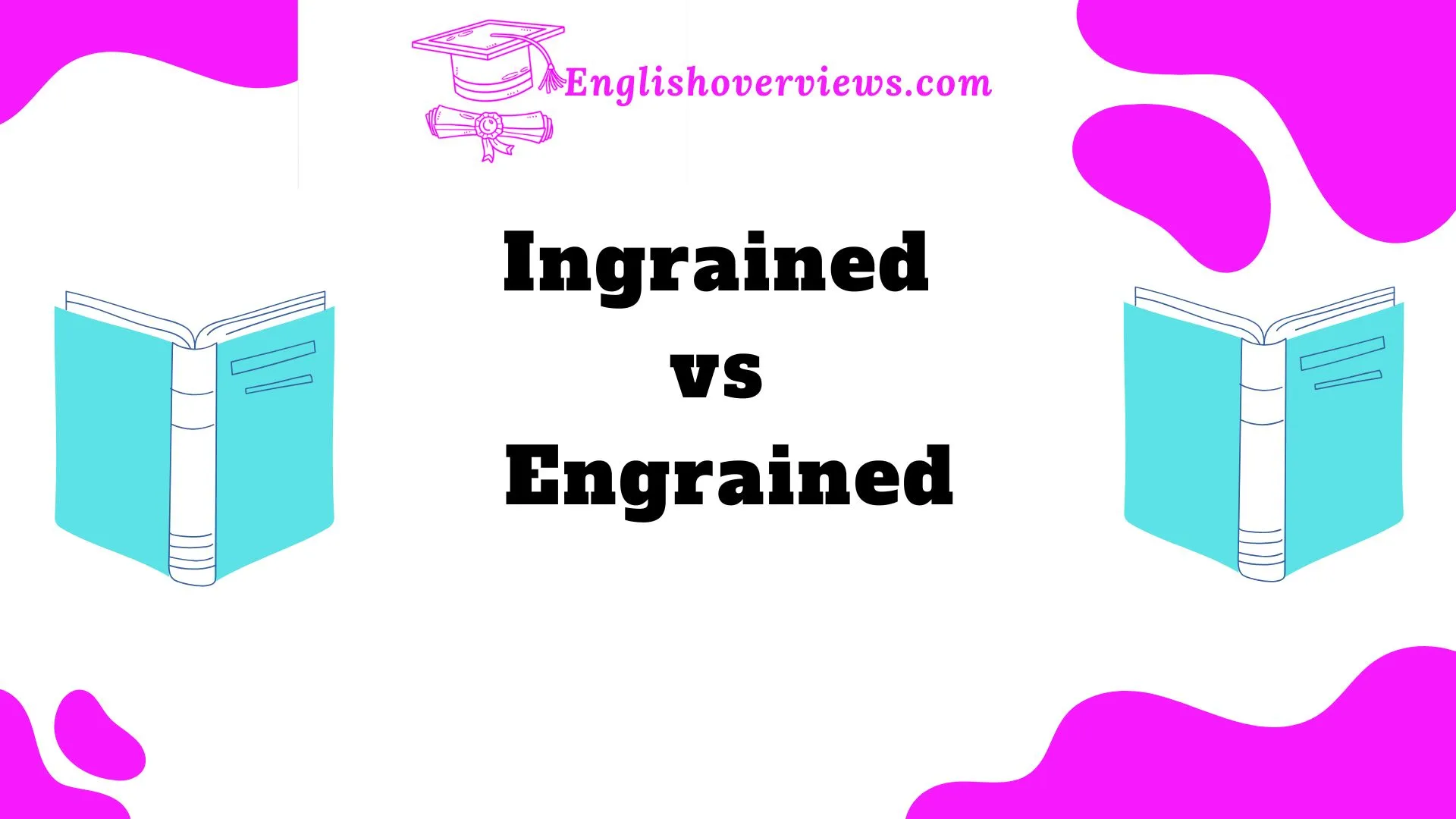In the world of language, it’s easy to get lost in similar-sounding words that seem interchangeable, but aren’t. “Ingrained” and “engrained” are two such words.
Both have similar meanings and even come from the same root, but their usage, history, and meanings can differ. So, which one should you use, and when?
This post aims to clear up the confusion between these two terms, dive deep into their histories, and provide practical advice on when to use each.
Whether you’re a writer, student, or just someone who loves words, you’ll get plenty of useful insights to help you understand these words more clearly.
By the end, you’ll know how to use “ingrained” with confidence, and maybe even understand when “engrained” might just be the better choice.
What Does ‘Ingrained’ Mean?
The term “ingrained” is most commonly used to describe something that is deeply embedded or firmly established. This can refer to physical things or abstract concepts like habits, beliefs, or attitudes. In simpler terms, when something is ingrained, it’s been thoroughly integrated into the fabric of a person or object.
For example:
- Ingrained habits: These are habits that have become second nature, almost impossible to change.
- Ingrained beliefs: These are ideas that have been so deeply accepted that challenging them feels unnatural.
Real-World Example:
- “Her ingrained politeness made her one of the most respected figures in the community.”
In this example, “ingrained” suggests that politeness is a habit that is so deeply a part of her personality that it’s almost automatic.
The Origin and Evolution of ‘Ingrained’
The word “ingrained” has its roots in the 15th century. Originally, it referred to something that was literally “woven into” or “dyed into” fabric. The term comes from the combination of “in” (meaning “inside”) and “grain” (meaning “texture” or “grain of a material”).
Over time, the word evolved into a more figurative sense, referring to something deeply embedded, like an idea or behavior. The metaphorical use began to take hold during the 17th century, and today it is used most frequently to describe habits, beliefs, and traits.
| Era | Meaning |
| 15th Century | Referring to the literal weaving of fabric |
| 17th Century | Transitioned to a metaphorical sense, meaning deeply embedded |
| Modern Use | Describes habits, traits, or beliefs that are difficult to change |
This evolution showcases how a word can shift over time, picking up new meanings and layers in the process.
Real-Life Examples of ‘Ingrained’ in Sentences
It’s always helpful to see how a word works in context. Here are a few real-life examples of how “ingrained” is used in sentences:
- “His ingrained sense of responsibility made him the perfect leader for the project.”
- “The ingrained tradition of celebrating the holiday together was passed down through generations.”
- “Her ingrained fear of public speaking held her back in meetings.”
In these examples, ingrained describes something that has become a deeply rooted part of the person or thing being discussed.
The Rarer Alternative: ‘Engrained’ – What’s the Difference?
While “ingrained” is the more common of the two terms, “engrained” does appear occasionally, often in more specialized contexts. The main difference between the two is subtle and mainly depends on style and preference.
“Engrained” is used to describe something that has been literally carved or imprinted into something. Think of something being engraved in stone—hard, permanent, and lasting. While “engrained” has a similar figurative meaning as “ingrained”, it often conveys a stronger sense of permanence.
Example of ‘Engrained’:
- “The engrained patterns of his thought process made it difficult for him to see things differently.”
In this context, engrained gives the impression of a more permanent, rigid pattern, as if the thought process is deeply marked, almost unchangeable.
Usage Tip:
If you’re unsure which word to use, “ingrained” is usually safe. “Engrained” tends to be rarer and is often associated with more literal, physical marks.
A Historical Overview: ‘Ingrained’ vs. ‘Engrained’
Let’s take a quick look at how these words have been used historically.
‘Ingrained’ vs. ‘Engrained’ – Usage Timeline:
| Term | First Recorded Use | Popular Usage | Typical Context |
| Ingrained | 15th Century | Most common today | Figurative (habits, beliefs) |
| Engrained | 17th Century | Less common | More literal (physical impressions) |
Historically, ingrained has seen the broader use, especially in metaphorical senses. Engrained, on the other hand, has been more reserved for descriptions of something permanently fixed in a physical or figurative sense.
Usage Trends in Literature, Media, and Publications
In today’s writing, “ingrained” is much more common than “engrained”. A quick scan of academic articles, books, or even casual writing shows that ingrained appears far more frequently, especially when discussing things like habits, culture, or personality traits.
Here are a few examples of both terms in modern publications:
- “Her ingrained love of reading was evident from a young age.” – Common, everyday writing.
- “The engrained designs on the ancient artifact showed signs of wear.” – Used in a more literal, historical context.
The trend is clear: “Ingrained” has become the preferred choice in most modern contexts, while “engrained” is more niche.
The Verbs Behind the Adjectives: ‘Ingrain’ vs. ‘Engrain’
Both ingrain and engrain have corresponding verbs, and understanding these can help clarify how their adjective forms came about.
The Verbs:
- Ingrain: To deeply embed something in a person or thing (e.g., ingraining a lesson, ingraining a habit).
- Engrain: To imprint or carve something onto a surface (e.g., engraining a design into wood).
The verb “ingrain” is much more common in everyday use than “engrain,” further solidifying “ingrained” as the more dominant form in modern language.
Why ‘Ingrained’ Wins in Modern Writing
In modern writing, “ingrained” holds the lead for several reasons:
- Broader applicability: It’s used for both physical and abstract contexts.
- More common: It appears more often in books, articles, and newspapers.
- Ease of understanding: Its meaning is more easily understood by the general public.
Quick Tips for Using ‘Ingrained’:
- Use “ingrained” when referring to habits, beliefs, or anything deeply embedded.
- Reserve “engrained” for contexts that require a stronger sense of permanence or physical imprints.
Conclusion: Key Takeaways
To sum up, “ingrained” is the most common and widely accepted choice in modern language, especially for figurative uses like habits, beliefs, or deeply held traits. “Engrained”, while still correct, is used less often and carries a stronger implication of something permanently etched or imprinted.
Next time you’re choosing between these two words, remember:
- Ingrained = deeply embedded, hard to change (more common)
- Engrained = permanently marked or imprinted (less common)
By understanding their subtle differences and historical backgrounds, you’ll be able to use both terms correctly and confidently.
So, whether you’re writing a formal essay or a casual blog post, you can ensure that you’re using the right word for the right situation.
FAQs
1. Can “engrained” be used in place of “ingrained”?
While both words have similar meanings, “ingrained” is far more common in modern usage. “Engrained” tends to be reserved for more literal contexts or to imply something more permanent.
2. Which is more widely used, “ingrained” or “engrained”?
“Ingrained” is the more widely used term in modern writing, especially when referring to habits, traditions, and personality traits.
3. Can “engrained” ever be the better choice?
Yes, “engrained” can be the better choice when referring to something physically etched or permanently marked, such as designs or imprints on materials.
By understanding these distinctions and keeping the nuances in mind, you’ll not only enhance your writing but also gain a deeper appreciation for the subtle evolution of language over time.

Alyan Ashraf is the creative mind behind English Overviews, a platform dedicated to helping learners master the English language. Passionate about education and language development, Alyan specializes in simplifying complex English concepts, making learning accessible for students of all levels.











